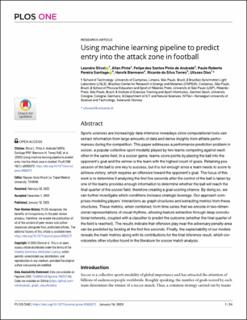| dc.contributor.author | Stival, Leandro | |
| dc.contributor.author | Pinto, Allan | |
| dc.contributor.author | Andrade, Felipe dos Santos Pinto de | |
| dc.contributor.author | Santiago, Paulo Roberto Pereira | |
| dc.contributor.author | Biermann, Henrik | |
| dc.contributor.author | Da Silva Torres, Ricardo | |
| dc.contributor.author | Dias, Ulisses | |
| dc.date.accessioned | 2023-10-24T08:16:03Z | |
| dc.date.available | 2023-10-24T08:16:03Z | |
| dc.date.created | 2023-03-06T09:25:41Z | |
| dc.date.issued | 2023 | |
| dc.identifier.issn | 1932-6203 | |
| dc.identifier.uri | https://hdl.handle.net/11250/3098251 | |
| dc.description.abstract | Sports sciences are increasingly data-intensive nowadays since computational tools can extract information from large amounts of data and derive insights from athlete performances during the competition. This paper addresses a performance prediction problem in soccer, a popular collective sport modality played by two teams competing against each other in the same field. In a soccer game, teams score points by placing the ball into the opponent’s goal and the winner is the team with the highest count of goals. Retaining possession of the ball is one key to success, but it is not enough since a team needs to score to achieve victory, which requires an offensive toward the opponent’s goal. The focus of this work is to determine if analyzing the first five seconds after the control of the ball is taken by one of the teams provides enough information to determine whether the ball will reach the final quarter of the soccer field, therefore creating a goal-scoring chance. By doing so, we can further investigate which conditions increase strategic leverage. Our approach comprises modeling players’ interactions as graph structures and extracting metrics from these structures. These metrics, when combined, form time series that we encode in two-dimensional representations of visual rhythms, allowing feature extraction through deep convolutional networks, coupled with a classifier to predict the outcome (whether the final quarter of the field is reached). The results indicate that offensive play near the adversary penalty area can be predicted by looking at the first five seconds. Finally, the explainability of our models reveals the main metrics along with its contributions for the final inference result, which corroborates other studies found in the literature for soccer match analysis. | en_US |
| dc.language.iso | eng | en_US |
| dc.publisher | PLOS | en_US |
| dc.rights | Navngivelse 4.0 Internasjonal | * |
| dc.rights.uri | http://creativecommons.org/licenses/by/4.0/deed.no | * |
| dc.title | Using machine learning pipeline to predict entry into the attack zone in football | en_US |
| dc.title.alternative | Using machine learning pipeline to predict entry into the attack zone in football | en_US |
| dc.type | Peer reviewed | en_US |
| dc.type | Journal article | en_US |
| dc.description.version | publishedVersion | en_US |
| dc.source.volume | 18 | en_US |
| dc.source.journal | PLOS ONE | en_US |
| dc.source.issue | 1 | en_US |
| dc.identifier.doi | 10.1371/journal.pone.0265372 | |
| dc.identifier.cristin | 2131393 | |
| cristin.ispublished | true | |
| cristin.fulltext | original | |
| cristin.qualitycode | 1 | |

